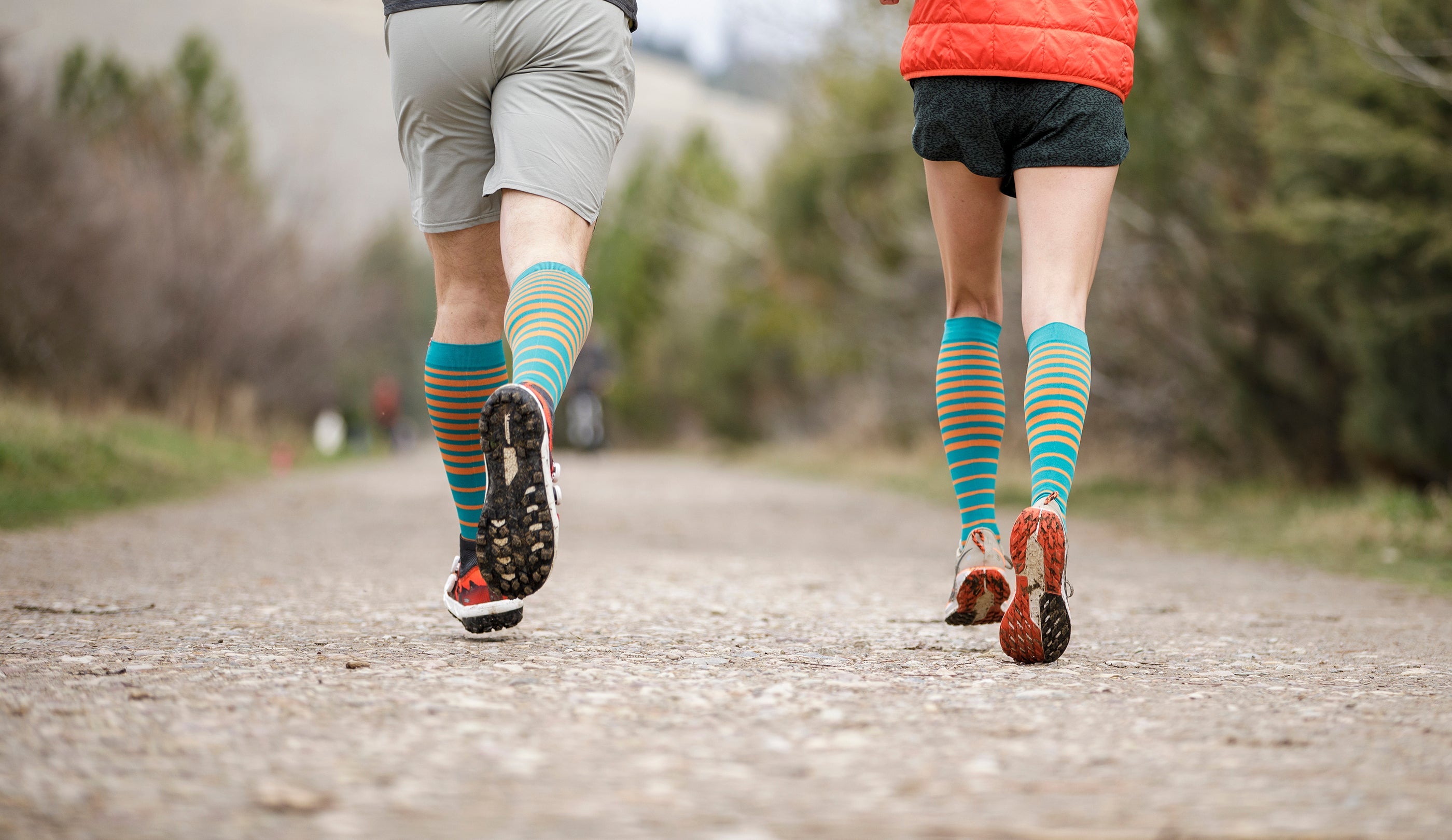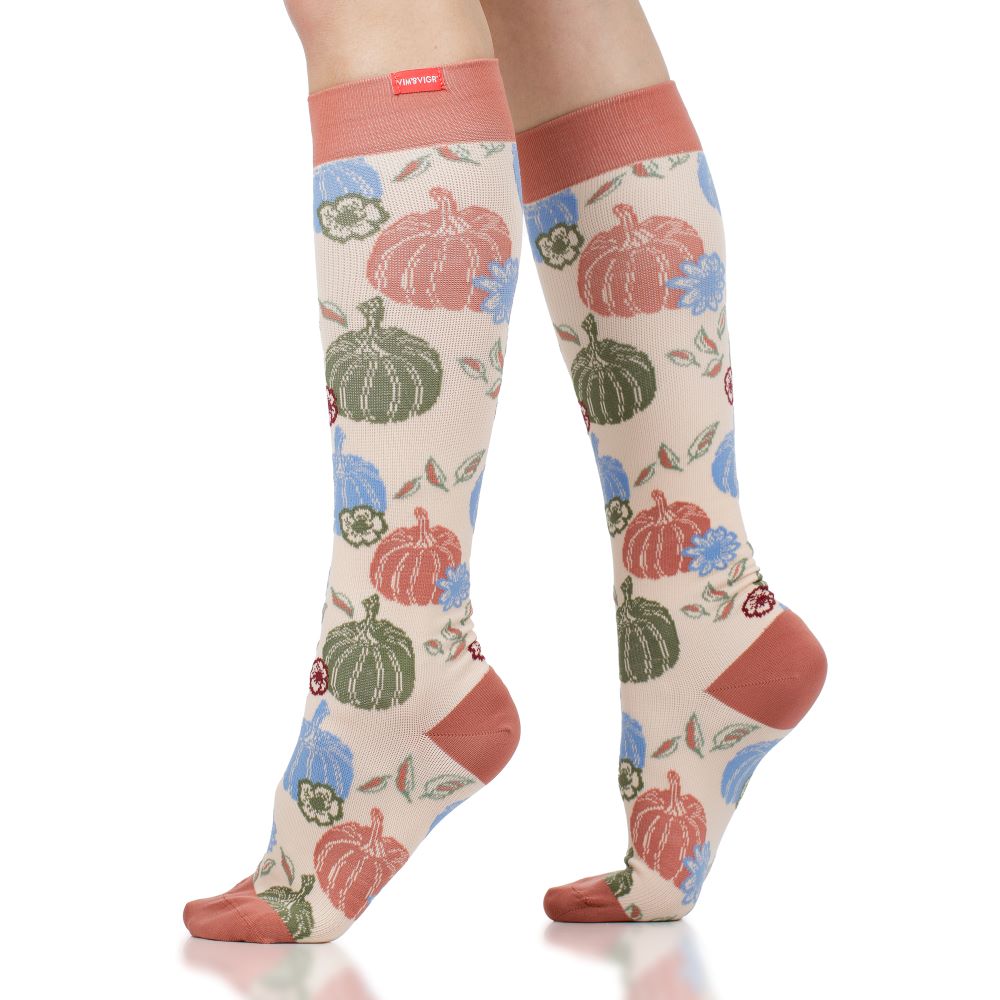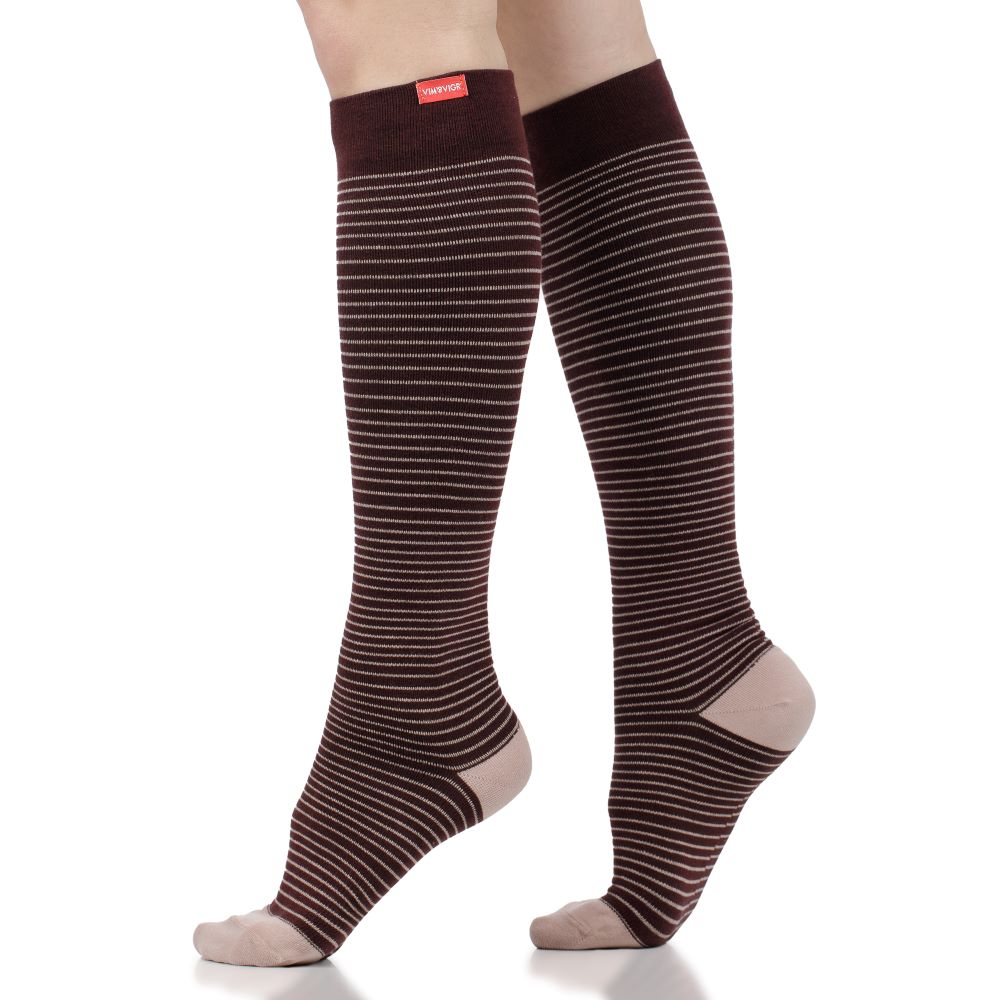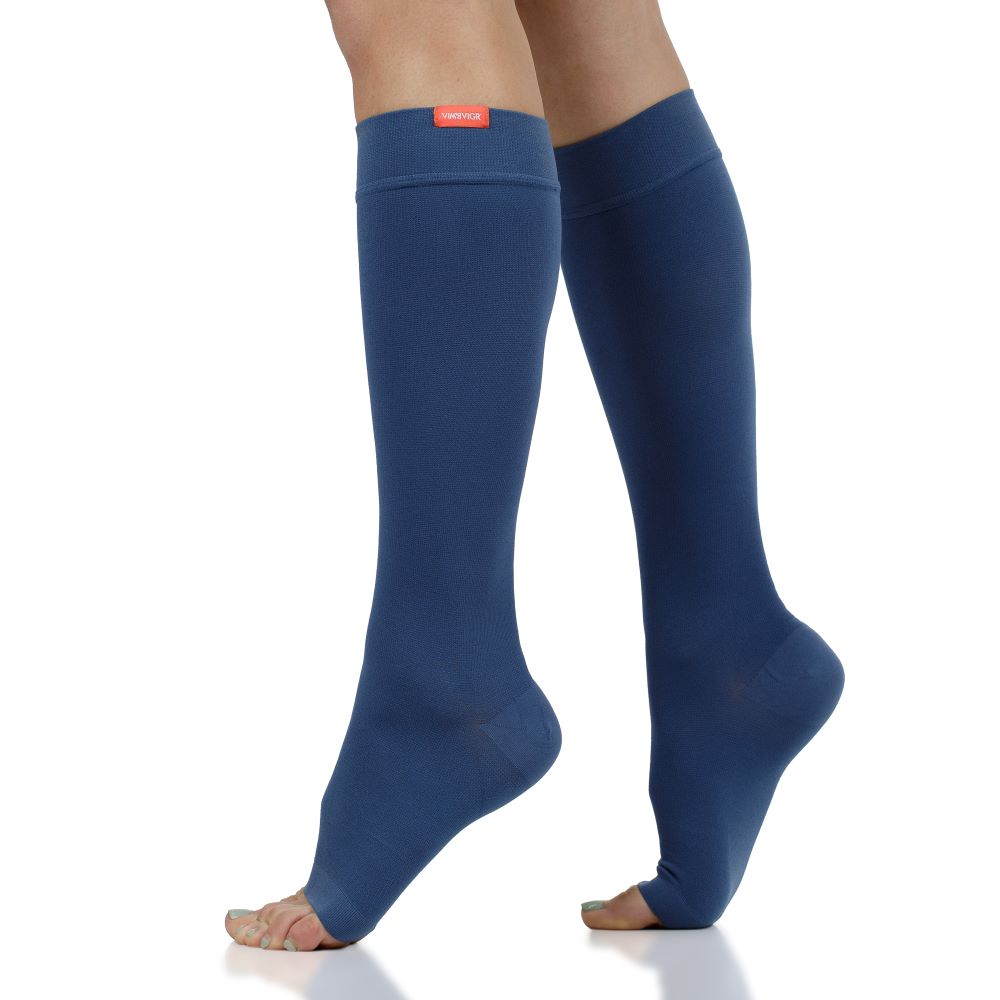Do Compression Socks Help or Prevent Varicose Veins?
Written By Alecsa Stewart
Scientifically Reviewed by Daniel Chantigian
Varicose veins happen when veins become unable to transport the blood from the limbs back to the heart. They appear when blood pressure increases inside of the veins causing damage to the walls or valves within them. Varicose veins can cause blood pool in the veins and put pressure on them. With weakened walls and damaged valves, varicose veins lead to not only an unsightly appearance on the legs but also to pain, discomfort, heavy legs and feet, and leg cramping at night.
So, can compression socks help treat varicose veins? Could compression socks prevent varicose veins? What is the role of compression socks in varicose vein treatment and how should you go about wearing them?
In this article, you will find out how compression stockings and socks improve blood circulation and support vein health. This helps manage the symptoms of varicose veins and could even prevent them from occurring.
Are Compression Socks Good for Varicose Veins?
Compression socks can improve blood circulation in the lower limbs and relieve the symptoms of varicose veins. By applying gentle pressure on the legs, they stimulate blood flow, massage the limbs, and offer additional support to the joints and muscles. This helps reduce inflammation and pain, increase circulation, and bring down swelling.
Thanks to the benefits of graduated compression stockings and socks on circulation, they may also prevent varicose veins in the first place.

How Do Compression Socks Help and Prevent Varicose Veins?
The main benefit of wearing graduated compression socks is their positive impact on circulation. Compression socks can increase blood flow and prevent edema, even in people with varicose veins according to one scientific study. Supporting peripheral blood flow with compression socks improves the wellbeing of patients with varicose veins or chronic venous disease, and it may reduce the risk of varicose veins in people with chronic venous disease. Compression socks may also prevent further complications for varicose veins while you wear them.
Improving Blood Flow
Varicose veins occur when the walls or valves in the veins weaken, which can prevent blood from traveling back to the heart. As a result, blood pools in the lower legs and makes the veins swell, leading to the typical visual representation of varicose veins and to pain and discomfort. Graduated compression socks help eliminate blood pooling in the periphery, ensuring that blood travels through the body continuously. While there is little evidence, one clinical report states that compression socks may effectively prevent varicose veins and treat their symptoms.
A 2002 study found that patients suffering from varicose veins and swelling could reduce their edema by wearing compression socks, especially by using socks that exert higher compression levels (20mmHg or higher). This scientific study provides evidence that compression socks help manage varicose veins symptoms and may prevent further complications.
Reducing Venous Pressure
Another benefit of using compression stockings and socks is that they take pressure off the veins and muscles, which can prevent blood vessel damage. This is why athletes use them a lot in sports such as running or playing tennis. Research shows that compression socks might improve exercise performance, reduce muscle soreness, and help athletes recover more quickly.
While compression socks cannot cure venous insufficiency, they help reduce the pressure on the veins and the swelling in the legs. They are also essential for lowering the risk of further complications, such as blood clots and deep vein thrombosis.

Preventing Venous Stasis
When your veins cannot transport blood from the legs back to the heart, blood can start leaking out of the veins and into the layers of your skin. This can cause you to experience venous stasis dermatitis. This condition starts with noticeably swollen ankles and visible varicose veins, accompanied by itching and pain. You will notice reddish or light brown skin forming around and above the ankles. In time, you can get sores or thickened skin.
As this is an advanced state of venous insufficiency and varicose veins, compression socks can help prevent venous stasis dermatitis in people with varicose veins. However, you should not wear any compression garments on rashes or open sores and cuts, as this can not only be painful, but can also lead to infection.
Can Compression Socks Reverse Varicose Veins?
Compression socks are a great tool for managing the symptoms of varicose veins, but they cannot reverse this condition. Medical reports have found that through improving blood flow and preventing blood from pooling in the veins, compression socks can help prevent varicose veins from getting worse. Additionally, if you struggle with peripheral blood flow or have a family history of circulatory problems, it is a good idea to wear compression socks to reduce your risk of preventable problems with blood vessels.
People who suffer from pins and needles, get swollen legs from long days traveling, or routinely have cold feet often have poor peripheral circulation. If you’re one of these people, wear compression socks when you sit or stand for long periods of time or when you go on a long flight. This will reduce your risk of developing varicose veins or deep vein thrombosis according to this study. You will also benefit from wearing them during physical activity, reducing pressure on the veins and the lower leg muscles. Our Vim & Vigr collection offers a variety of designs in fabrics adapted to your activity levels - for example, go for nylon or merino wool for running, while you can spend all day in soft, comfortable cotton.
How Many Hours Should I Wear Compression Socks for Varicose Veins?
How long you wear compression socks depends on your personal preference. A few hours at a time will be the bare minimum to start noticing any effects. We recommend starting with wearing them for 2-3 hours on your first try, especially if you are completely new to the feeling of pressure on your limbs. You can then slowly increase the length of time you wear them for, and you can even start wearing them for 24 hours.
If you have a prescription for compression socks from your doctor, your provider should advise you on the length of time to wear them. Most such garments are safe to wear for several hours, and you can even wear our 15-20 mmHg socks all day long if you need to!

Choosing the Best Compression Socks to Help Varicose Veins
If you are starting to wear compression socks for varicose veins for the first time, you may need some help choosing a pair that works best for you. Here are a few factors to consider.
Sizing and Fit
The right size of compression sock is essential for getting the benefits for treating varicose vein symptoms. Your socks need to be tight enough to exert pressure and support but not so tight that they cut off your circulation or become uncomfortable. If you go for loose socks, you will simply not see any improvement in your condition.
Make sure you’re wearing the right size by following our guide, starting with measuring your calf circumference and matching it against your normal shoe size. When you receive your socks, ensure you put them on correctly, fitting the heel and toes firmly against the respective ends of the sock and pulling the sock up to just below your knee. You will feel pressure on the calf muscles and shins, as well as at the ankle level.
Finally, you need to ensure there are no folds, kinks or bunching in the sock. Smooth it out over your legs slowly. This ensures you do not experience any rubbing or get blisters or bruises from an improperly fitted item.
Style and Material
At Vim & Vigr, we believe in stylish compression that fits into your life seamlessly. After all, you want to be able to wear your socks at work, on a night out, or when you travel. That is how you’ll keep your legs from swelling and keep boosting blood flow!
Firstly, consider what design of compression garment you need:
- The classic knee-high compression socks with graduated pressure boost blood flow out from the legs to help you protect the lower legs, while giving your muscles a welcome massage.
- Open-toe compression socks allow your toes to breathe and can be worn with sandals.
- Varicose veins patients who run or need to keep their feet well-ventilated can also use compression sleeves which cover the calf muscles and stimulate blood flow between the ankle and the knee - however, this style is less effective for preventing pooling around the ankles;
- Full-length leggings and tights are a great option for fuller coverage and to support the circulation in the upper legs.
Fabric is also an important choice since it will influence how comfortable and breathable your socks are. Here are our recommendations based on the Vim & Vigr range:
- Cotton can be worn all day, every day, in work and casually. Our socks are made with 200-needle count cotton and provide comfort and lightweight. However, cotton doesn’t breathe as well as other fabrics and doesn’t wick away moisture effectively.
- Nylon is exceptionally flexible and stretchy, which makes it great for working out. Our socks are made with 400 needle-count nylon which is also breathable.
- Merino wool is exceptionally breathable, moisture wicking, and antibacterial. It’s the fabric of choice for running, walking, and staying cool or warm no matter the weather conditions.
- Our moisture-wick nylon has been especially designed to draw sweat and moisture from the skin, while offering stretch and flexibility;
- Our choice nylon design is everything you love about nylon socks, without the toe seam, so with less risk of chafing or rubbing.
Compression Level
To ensure you get the pressure you need for your vein health, we offer three levels of compression, measured in mmHg:
- 15-20 mmHg is for beginners and those looking to wear compression socks to prevent swelling, clotting, and varicose veins from appearing; they are also well suited to sports activities.
- 20-30 mmHg is for those recovering from surgery or injury, who already suffer from varicose veins or edema, and whose doctors have recommended compression socks because of circulation problems.
- 30-40 mmHg socks are prescription-only and will be most suited to patients with chronic venous insufficiency or other more serious health concerns.
Graduated Compression vs Conventional Compression
Not sure if you need graduated compression versus “just” compression socks? For varicose veins patients and those at risk of developing this condition, upward blood flow is essential. With graduated compression, the ankles are squeezed tighter than the top of the lower leg, and pressure decreases gradually as the sock climbs. This effectively stimulates the movement of blood out of the lower leg and helps prevent pooling around the ankles. Conventional compression garments, on the other hand, apply the same level of pressure for the entire length of the sock. This still stimulates blood flow and massages and supports the muscles but does not have the same strength of “pushing” the blood up from the ankles. This is why we recommend graduated compression socks when you want to prevent or manage varicose veins.
References
National Heart, Lung, and Blood Institute. (2023). Varicose Veins. Nhlbi.nih.gov. Read it here.
Hirai, M., Iwata, H., & Hayakawa, N. (2002). Effect of elastic compression stockings in patients with varicose veins and healthy controls measured by strain gauge plethysmography. Skin research and technology : official journal of International Society for Bioengineering and the Skin (ISBS) [and] International Society for Digital Imaging of Skin (ISDIS) [and] International Society for Skin Imaging (ISSI), 8(4), 236–239. Read it here.
Tan, M., Urbanek, T., Rabe, E., Gianesini, S., Parsi, K., Davies, A. H., & UIP (2024). Compression therapy in the management of varicose veins. Phlebology, 39(4), 276–279. Read it here.
Charles, T., Mackintosh, D., Healy, B., Perrin, K., Weatherall, M., & Beasley, R. (2011). Merino wool graduated compression stocking increases lower limb venous blood flow: a randomized controlled trial. Advances in therapy, 28(3), 227–237. Read it here.
Moñux, G., Serna-Soto, M., Plá-Sanchez, F., Zamorano-León, J. J., Segura, A., Rial, R., Freixer, G., Zekri-Nechar, K., Hugo-Martínez, C., Serrano, J., & López-Farré, A. (2021). Compression stockings attenuate the expression of proteins associated with vascular damage in human varicose veins. Journal of vascular surgery. Venous and lymphatic disorders, 9(2), 428–434. Read it here.
Antani MR, Dattilo JB. Varicose Veins. [Updated 2023 Aug 8]. In: StatPearls [Internet]. Treasure Island (FL): StatPearls Publishing; 2024 Jan-. Read it here.
Clarke, M. J., Broderick, C., Hopewell, S., Juszczak, E., & Eisinga, A. (2021). Compression stockings for preventing deep vein thrombosis in airline passengers. The Cochrane database of systematic reviews, 4(4), CD004002. Read it here.


















Leave a comment